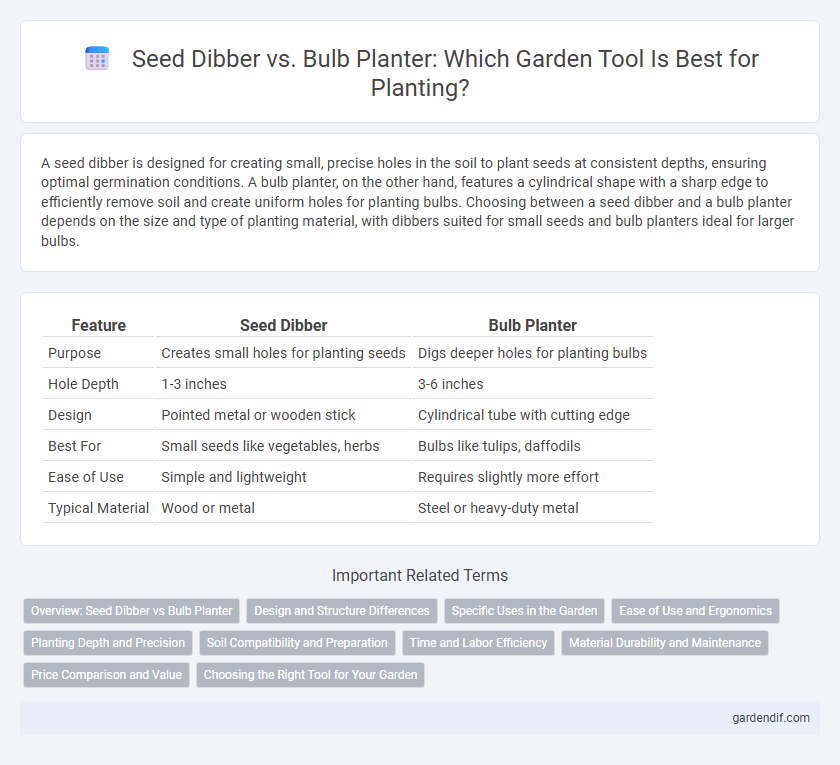
Seed Dibber vs Bulb Planter Illustration
A seed dibber is designed for creating small, precise holes in the soil to plant seeds at consistent depths, ensuring optimal germination conditions. A bulb planter, on the other hand, features a cylindrical shape with a sharp edge to efficiently remove soil and create uniform holes for planting bulbs. Choosing between a seed dibber and a bulb planter depends on the size and type of planting material, with dibbers suited for small seeds and bulb planters ideal for larger bulbs.
Table of Comparison
| Feature | Seed Dibber | Bulb Planter |
|---|---|---|
| Purpose | Creates small holes for planting seeds | Digs deeper holes for planting bulbs |
| Hole Depth | 1-3 inches | 3-6 inches |
| Design | Pointed metal or wooden stick | Cylindrical tube with cutting edge |
| Best For | Small seeds like vegetables, herbs | Bulbs like tulips, daffodils |
| Ease of Use | Simple and lightweight | Requires slightly more effort |
| Typical Material | Wood or metal | Steel or heavy-duty metal |
Overview: Seed Dibber vs Bulb Planter
Seed dibbers are pointed tools designed for creating precise holes in the soil for planting seeds, ensuring optimal depth and spacing. Bulb planters feature a cylindrical shape with a hollow shaft to remove soil plugs, facilitating the planting of bulbs at uniform depths quickly and efficiently. Both tools enhance planting accuracy but cater to different garden tasks--seed dibbers for small seeds and bulb planters for larger bulbs.
Design and Structure Differences
Seed dibbers feature a tapered, pointed design ideal for creating precise holes in soil for seeds, often with a slender handle for easy control. Bulb planters have a cylindrical, hollow structure that extracts soil plugs, allowing for uniform planting depths of bulbs. This structural difference optimizes seed dibbers for accuracy and bulb planters for consistent hole size and depth in horticultural tasks.
Specific Uses in the Garden
A seed dibber is designed specifically for creating small, precise holes ideal for planting individual seeds or seedlings, ensuring proper depth and spacing in garden beds. In contrast, a bulb planter is built to dig deeper, wider holes suitable for larger bulbs, providing enough room for root expansion and optimal growth conditions. Using each tool according to its purpose enhances planting efficiency and promotes healthier plant development.
Ease of Use and Ergonomics
Seed dibbers offer superior precision and control for planting small seeds, featuring pointed tips that penetrate soil easily with minimal effort. Bulb planters are designed with ergonomic handles and a hollow cylindrical blade, enabling quick removal of soil plugs for planting bulbs efficiently. The comfortable grip and lightweight construction of both tools reduce hand fatigue, but seed dibbers excel in maneuverability for delicate seed placement.
Planting Depth and Precision
A seed dibber offers precise control for planting small seeds at exact depths ranging from 1 to 3 inches, ensuring optimal germination and spacing. In contrast, a bulb planter is designed to create uniform holes typically 4 to 6 inches deep, ideal for larger bulbs but less versatile for varied planting depths. Selecting the right tool depends on the required planting depth and precision to enhance growth success.
Soil Compatibility and Preparation
A seed dibber excels in preparing lightweight, well-drained soils by creating precise holes for planting seeds at consistent depths, which is ideal for fine, loose soil textures. Bulb planters are better suited for heavier, compacted soils, as their tubular design efficiently extracts soil plugs, allowing for easy bulb placement without excessive soil disturbance. Selecting the appropriate tool based on soil compatibility optimizes planting efficiency and promotes healthier root development.
Time and Labor Efficiency
A seed dibber offers quick, precise holes for individual seeds, significantly reducing time spent on planting small crops. In contrast, a bulb planter allows for faster planting of larger bulbs by creating uniform, deeper holes with less bending and effort. Choosing between the two tools depends on crop size and soil conditions, but both optimize labor efficiency by minimizing physical strain and speeding up the planting process.
Material Durability and Maintenance
Seed dibbers typically feature wooden or plastic handles with metal tips, providing moderate durability but requiring regular cleaning and occasional oiling to prevent rust. Bulb planters, often constructed from heavy-duty steel or aluminum with corrosion-resistant coatings, offer superior longevity and demand less maintenance due to their robust, rust-proof materials. Choosing a bulb planter ensures enhanced material durability and minimal upkeep compared to the more maintenance-intensive seed dibber.
Price Comparison and Value
Seed dibbers typically cost between $5 to $15, offering an affordable option for precise seed planting. Bulb planters range from $15 to $30, often providing greater versatility and durability for planting larger bulbs or multiple seeds at once. While seed dibbers excel in budget-friendly, small-scale gardening, bulb planters deliver enhanced value through multifunctional use and sturdier construction.
Choosing the Right Tool for Your Garden
Selecting the right garden tool significantly impacts planting efficiency and crop success, with seed dibbers ideal for precise seed placement in small holes and bulb planters designed to create larger cavities for bulbs. Seed dibbers offer controlled depth and spacing for tiny seeds, enhancing germination rates, while bulb planters reduce soil disruption and make planting deeper, larger bulbs easier. Understanding the specific needs of your garden, including seed size and soil type, ensures you choose between a seed dibber or bulb planter to optimize growth and maintain soil health.
Seed Dibber vs Bulb Planter Infographic

 gardendif.com
gardendif.com